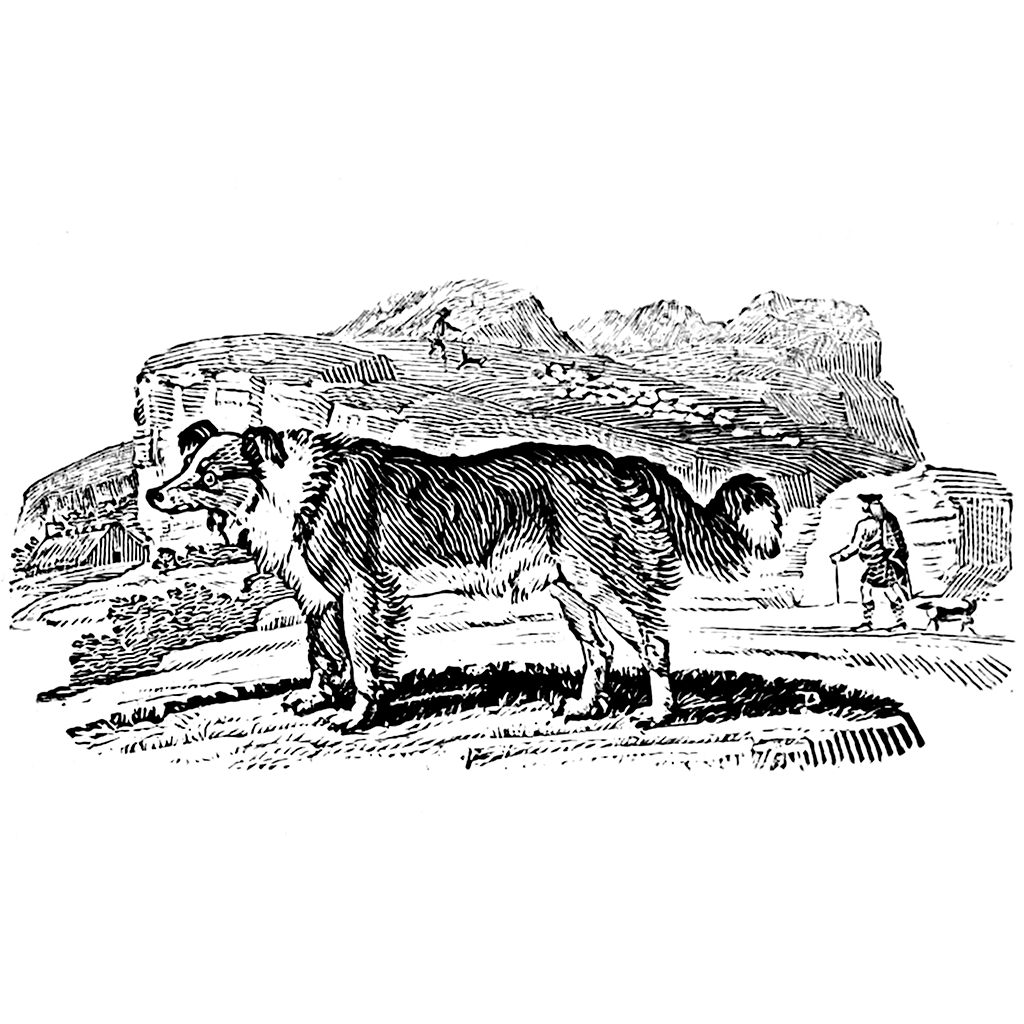“My Kingdom for a Barking Dog!”
A Critical History of Sheepdog Trialling with Border Collies, and Why It Matters to Sheep
DOI:
https://doi.org/10.52537/humanimalia.20155Keywords:
sheepdog trials, herding dogs, border collies, shepherding, sheep welfareAbstract
According to Raymond and Lorna Coppinger, experts in canine behaviour, sheepdog trialling with Border Collies is mostly for fun. The British International Sheep Dog Society (ISDS), however, contends that trialling has the practical aim of improving the collie as a working dog. So who is right? I take a historical approach to answer this question, using the wealth of data contained in The Field, a magazine established in 1853, to investigate the sport’s history and relation to practical shepherding.
Trialling in Britain started in 1873, and in the following decades, the dogs and shepherds’ trialling behaviour underwent a stylization that has clear overtones of genteel notions of manliness. Soon after the first trials, however, critics pointed out that the collies’ specific working style made them less, rather than more suitable for practical shepherding. Other critics objected that the course design did not reflect daily farm work and that training for the trials placed an unacceptable burden on the sheep.
In response, the ISDS, established in 1906, restructured the trials to make them more ‘workmanlike.’ This did not end the discussion of their usefulness, however, which continued unabated. Today, in Britain and other sheep farming countries, many shepherds are critical of the trial collie and prefer a different type of dog. The trial collie, I conclude, is to be seen as a sporting dog, bred specifically for trialling. Their use is indeed mostly for fun.
In the final section, I raise questions with respect to trialling and sheep welfare. I will discuss an alternative approach to shepherding in which the sheep are not driven but led by the shepherd. This alternative has practical merits and benefits sheep welfare.
Downloads
References
The Agrarian History of England and Wales. 8 vols. Cambridge: Cambridge University Press, 1967–2011.
Barrios, Natasha, Alvaro Fuenzalida, Marcelo Gómez, Consuelo Heuser, Rodrigo Muñoz, Elaine A. Ostrander, Heidi G. Parker, and César González-Lagos. “The Patagonian Sheepdog: Historical Perspective on a Herding Dog in Chile.” Diversity 11, no. 12 (2019): 245. https://doi.org/10.3390/d11120245.
Beilby, Ralph, and Thomas Bewick. A General History of Quadrupeds. Newcastle upon Tyne: S. Hodgson, R. Beilby, & T. Bewick, 1790.
Billingham, Viv. One Woman and Her Dog. Moffat: Lochar Publishing, 1988.
Bingley, William, and Samuel Howett. Memoirs of British Quadrupeds, Illustrative Principally of Their Habits of Life, Instincts, Sagacity, and Uses to Mankind. London: Darton and Harvey, 1809.
Bremner, K. J., J. B. Braggins, and R. Kilgour. “Training Sheep as ‘Leaders’ in Abattoirs and Farm Sheep Yards.” Proceedings of the New Zealand Society of Animal Production 40 (1980): 111–16.
Brown, Geoff. Herdwicks: Herdwick Sheep and the English Lake District. South Stanmore (Cumbria): Hayloft, 2009.
Brown, Thomas. Biographical Sketches and Authentic Anecdotes of Dogs. Edinburgh: Oliver and Boyd, 1829.
Caius, Johannes. Of Englishe Dogges: The Diuersities, the Names, the Natures, and the Properties. Translated by Abraham Fleming. London, 1576.
Carpenter, E. B. The Blue Riband of the Heather: The Supreme Champions 1906–88. Ipswich: Farming Press, 1989.
Clark, Noreen R. A Dog for the Job: Australia’s Cattle Dogs. Calwell: Inspiring Publishers, 2022.
Combe, Iris. Border Collies. London: Faber & Faber, 1978.
Combe, Iris. Shepherds, Sheep and Sheepdogs: A Feminine View of Shepherding Life and Customs. Clapham: Dalesman Books, 1983.
Coppinger, Raymond and Lorna Coppinger. Dogs: A New Understanding of Canine Origin, Behavior and Evolution. Chicago: The University of Chicago Press, 2002.
Coulthard, Sally. Follow the Flock: How Sheep Shaped Human Civilization. New York: Pegasus, 2021.
Cropper, Jim. The Dog Man. As told to Edward Hart. York: WSN, 2005.
Dalziel, Hugh. British Dogs: Their Varieties, History, Characteristics, Breeding, Management and Exhibition. London: The Bazaar Office, [1879].
Derry, Margaret E. Bred for Perfection: Shorthorn Cattle, Collies, and Arabian Horses Since 1800. Baltimore, MD: Johns Hopkins University Press, 2003.
Despret, Vinciane. “Sheep Do Have Opinions.” In Making Things Public. Atmospheres of Democracy, edited by Bruno Latour and Peter Weibel, 360–70. Cambridge, MA: MIT Press, 2006.
Despret, Vinciane and Michel Meuret. “Cosmoecological Sheep and the Arts of Living on a Damaged Planet.” Environmental Humanities 8, no. 1 (2016): 24–36. https://doi.org/10.1215/22011919-3527704.
Edwards, Sydenham T. Cynographia Britannica [...]. London, 1800.
Ellis, William. A Compleat System of Experienced Improvements, Made on Sheep, Grass-Lambs, and House-Lambs […]. London, 1749.
The Field: The County Gentleman’s Newspaper. London: Field Office, 1853–1911.
Fiore, Ivana and Francesca Lugli, eds. Dogs, Past and Present: An Interdisciplinary Perspective. Oxford: Archaeopress, 2023.
Franklin, Sara. Dolly Mixtures: The Remaking of Genealogy. Durham, NC: Duke University Press, 2007.
Fraser, Allen. Animal Husbandry Heresies. London: Crosby Lockwood & Son, 1960.
Gosset, Adelaide L.J. Shepherds of Britain: Scenes from Shepherd Life Past and Present from the Best Authorities. London: Constable and Company, 1911.
Grew, Sheila. Key Dogs from the Border Collie Family. Hernando, MS.: Heritage Farms Pub, 1993.
Halsall, Eric. British Sheepdogs, Being the History of the International Sheep Dog Society. Burnley: Turner and Earnshaw, 1992.
Halsall, Eric. Sheepdog Trials. Cambridge: Patrick Stevens, 1982.
Hancock, David. Dogs of the Shepherds: A Review of the Pastoral Breeds. Ramsbury: Crowood Press, 2014.
Haraway, Donna J. When Species Meet. Minneapolis: University of Minnesota Press, 2008.
Hart, Edward. The Hill Shepherd. Newton Abbot: David and Charles, 1977.
Hogg, James. The Shepherd’s Calendar. Edinburgh: William Blackwood, 1829.
Holmes, John. The Farmer’s Dog. London: Popular Dogs Publishing Co., 1975.
Hunter, James. “Sheep and Deer: Highland Sheep Farming, 1850–1900,” Northern Scotland 1, no. 1 (1972): 199–222. https://doi.org/10.3366/nor.1972.0015.
Jones, Edward W. H. Sheep-Dog Trials and the Sheep-Dog [...]. Brecon: Edwin Poole, 1892.
Kendrick, Keith M., Ana P. da Costa, Andrea E. Leigh, Michael R. Hinton, and Jon W. Peirce . “Sheep Don’t Forget a Face.” Nature 414, no. 6860 (2001): 165–66. https://doi.org/10.1038/35102669.
Knolle, Franziska, Rita P. Goncalves, and A. Jennifer Morton. “Sheep Recognize Familiar and Unfamiliar Human Faces from Two-Dimensional Images.” Royal Society Open Science 4, no. 11 (2017). https://doi.org/10.1098/rsos.171228.
Lee, Rawdon Briggs. A History and Description of the Collie or Sheep Dog in His British Varieties. London: H. Cox, 1890.
Leighton, Robert. The New Book of the Dog: A Comprehensive Natural History of British Dogs and their Foreign Relatives, with Chapters on Law, Breeding, Kennel Management, and Veterinary Treatment. London: Cassell and Company, 1907.
Little, John. Practical Observations on the Improvement and Management of Mountain Sheep, and Sheep Farms. Edinburgh: John Moir, 1815.
MacDonald, James. Stephen’s Book of the Farm. 5th ed. Edinburgh and London: William Blackwood and Sons, 1908.
Malden, Walter James. British Sheep and Shepherding. London: MacDonald & Martin, 1915.
Martin, W.C.L. The History of the Dog: Its Origin, Physical and Moral Characteristics, and its Principal Varieties. London: Charles Knight & Co., 1845.
Mascall, Leonard. The First Booke of Cattell […]. London, 1587.
McCaig, Donald. Mr. and Mrs. Dog: Our Travels, Trials, Adventures, and Epiphanies. Charlottesville: University of Virginia Press, 2013.
McCulloch, John Herries. Border Collie Studies. Edinburgh: The Pentland Press, 1952.
McCulloch, John Herries. Sheep Dogs and their Masters: Being a History of the Border Collie, Together with Some Notes About the Men Who Have Developed the Breed. Dumfries: Robert Dinwiddie, 1938.
Meyrick, John. House Dogs and Sporting Dogs. London: Taylor and Francis, 1861.
Mundell, Matt. Country Diary. Edinburgh: Gordon Wright Publishing, 1981.
Rebanks, James. The Shepherd’s Life: A Tale of the Lake District. London: Allen Lane, 2015.
Reid, James A. “Sheepdog Trials.” In The Book of the Dog, edited by Brian Vesey-Fitzgerald, 736–51. London: Nicholson & Watson, 1948.
Ritvo, Harriet. The Animal Estate: The English and Other Creatures in Victorian England. Cambridge, MA: Harvard University Press, 1987.
Ritvo, Harriet. The Platypus and the Mermaid, and Other Figments of the Classifying Imagination. Cambridge, MA: Harvard University Press, 1997.
Rowell, T. E. “Till Death Do Us Part: Long-Lasting Bonds between Ewes and their Daughters.” Animal Behaviour 42, no. 4 (1991): 681–82. https://doi.org/10.1016/S0003-3472(05)80249-0.
Rowell, T. E., and C. A. Rowell, “The Social Organization of Feral Ovis aries Ram Groups in the Pre-rut Period.” Ethology 95, no. 3 (1993): 213–32. https://doi.org/10.1111/j.1439-0310.1993.tb00472.x.
Savalois, Nathalie, Nicolas Lescureux, and Florence Brunois. “Teaching the Dog and Learning from the Dog: Interactivity in Herding Dog Training and Use.” Anthrozoös 26, no. 1 (2013): 77–91. https://doi.org/10.2752/175303713X13534238631515.
Shaw, Vero. The Illustrated Book of the Dog. London: Cassell, Fetter, Galpin & Co., 1881.
Smith, Charles Hamilton. The Natural History of Dogs. Vol. 1. Edinburgh: Lizars, 1839.
St. John, Charles. Short Sketches of the Wild Sports and Natural History of the Highlands. London: John Murray, 1849.
Stephens, Henry. The Book of the Farm: Detailing the Labors of the Farmer, Steward, Plowman, Hedger, Cattle-Man, Shepherd, Field-Worker, and Dairymaid. New York: C. M. Saxton, 1851.
Stonehenge [John Henry Walsh], ed. The Dogs of the British Islands. 2nd ed. London: Horace Cox, 1872.
Taplin, William. The Sportsman’s Cabinet: Or, a Correct Delineation of the Various Dogs Used in the Sports of the Field. London: J. Cundee, 1804.
Tosh, John. Manliness and Masculinities in Nineteenth-Century Britain: Essays on Gender, Family and Empire. Harlow: Pearson Longman, 2005.
Trow-Smith, Robert. A History of British Livestock Husbandry, 1700–1900. London: Routledge and Kegan Paul, 1959.
Urdank, Albion. “The Rationalisation of Rural Sport: British Sheepdog Trials, 1873–1946.” Rural History 17, no. 1 (2006): 65–82. https://doi.org/10.1017/S0956793305001603.
Walling, Philip. Counting Sheep: A Celebration of the Pastoral Heritage of Britain. London: Profile Books, 2014.
Welker, Martin H., et al. “A Wolf in Sheep’s Clothing: The Development of Livestock Guarding Dogs in the Adriatic Region of Croatia.” Journal of Archaeological Science: Reports 42 (2022). https://doi.org/10.1016/j.jasrep.2022.103380.
Westling, Louise. “The Zoosemiotics of Sheep Herding with Dogs,” In The Semiotics of Animal Representations, edited by Kadri Tüür and Morten Tønnessen, 31–52. Leiden: Brill, 2014.
White, Ian. Transforming Fell and Valley: Landscape and Parliamentary Enclosure in North West England. Lancaster: Centre for North-West Regional Studies, 2003.
Woods, Rebecca. The Herds Shot Round the World. Native Breeds and the British Empire, 1800–1900. Chapel Hill: University of North Carolina Press, 2017.
Worboys, Michael, Julie-Marie Strange, and Neil Pemberton. The Invention of the Modern Dog: Breed and Blood in Victorian Britain. Baltimore: Johns Hopkins University Press, 2018.
Youatt, William. The Dog. London: Charles Knight and Co, 1845.

Published
Issue
Section
License
Copyright (c) 2025 Bert Theunissen (Author)

This work is licensed under a Creative Commons Attribution 4.0 International License.









